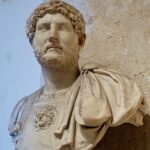Antinous was a Greek youth from Bithynia (he was born in Claudiopolis – the current city of Bolu, in Turkey), who when was 12 years old was taken in by the court of Hadrian. Emperor Hadrian met him during one of his many journeys and – delighted with his beauty – made him his lover.
Hadrian met the boy in 123 CE and he became his favorite in 128 CE. The young man accompanied the emperor on numerous trips as a personal entourage, including to Athens or Libya. It was not a big secret that Antinous was a lover of Emperor Hadrian, which was also approved by Empress Vibia Sabina herself (her relationship with Hadrian was formal and devoid of feelings).
In September / October 130 BCE, during a Nile fleet trip, Antinous unexpectedly died in mysterious circumstances. There were many suspicions about his death, from accidental drowning; post-castration complications (reportedly done at the request of Hadrian); after making a sacrifice to heal Hadrian who has been ill for a long time.
Regardless of the causes of death, the loss of his lover hurt Hadrian very much. In 137 CE Hadrian founded a city in this place – Antinopolis – where Antinous was announced a hero. There were huge temples built and organized games in his honour. The most important temple stood in Mantinei in Arcadia. In addition, he ordered to perform huge amounts of sculptures and portraits of a lover. The cult of Antinous survived until the fall of Rome, but it was often criticized by both Christians and believers in the traditional deities of the Romans.
Antinous’s appearance was depicted in sculpture, on coins and gems as the ideal of youthful beauty. To this day, many images of Antinous have been preserved.







